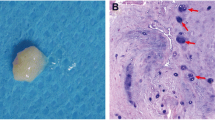Summary
Mesenchymal stem cells (MSCs) were induced into a nucleus pulposus-like phenotype utilizing simulated microgravity in vitro in order to establish a new cell-based tissue engineering treatment for intervertebral disc degeneration. For induction of a nucleus pulposus-like phenotype, MSCs were cultured in simulated microgravity in a chemically defined medium supplemented with 0 (experimental group) and 10 ng/mL (positive control group) of transforming growth factor β1 (TGF-β1). MSCs cultured under conventional condition without TGF-β1 served as blank control group. On the day 3 of culture, cellular proliferation was determined by WST-8 assay. Differentiation markers were evaluated by histology and reverse transcriptase-polymerase chain reaction (RT-PCR). TGF-β1 slightly promoted the proliferation of MSCs. The collagen and proteoglycans were detected in both groups after culture for 7 days. The accumulation of proteoglycans was markedly increased. The RT-PCR revealed that the gene expression of Sox-9, aggrecan and type II collagen, which were chondrocyte specific, was increased in MSCs cultured under simulated microgravity for 3 days. The ratio of proteoglycans/collagen in blank control group was 3.4-fold higher than positive control group, which denoted a nucleus pulposus-like phenotype differentiation. Independent, spontaneous differentiation of MSCs towards a nucleus pulposus-like phenotype in simulated microgravity occurred without addition of any external bioactive stimulators, namely factors from TGF-β family, which were previously considered necessary.
Similar content being viewed by others
References
Macfarlane GJ, Thomas E, Croft PR, et al. Predictors of early improvement in low back pain amongst consulters to general practice: the influence of pre-morbid and episode-related factors. Pain, 1999,80(1–2):113–119
Luoma K, Riihimäki H, Luukkonen R, et al. Low back pain in relation to lumbar disc degeneration. Spine, 2000,25(4):487–492
Gruber HE, Leslie K, Ingram J, et al. Cell based tissue engineering for the intervertebral disc: in vitro studies of human disc cell gene expression and matrix production within selected cell carriers. Spine J, 2004,4(1):44–55
Maroudas A, Stockwell RA, Nachemson A, et al. Factors involved in the nutrition of the human lumbar intervertebral disc: Cellularity and diffusion of glucose in vitro. J Anat, 1975,120(Pt 1):113–130
Pittenger MF, Mackay AM, Beck SC, et al. Multilineage potential of adult human mesenchymal stem cells. Science, 1999,284(5411):143–147
Mastrogiacomo M, Cancedda R, Quarto R. Effect of different growth factors on the chondrogenic potential of human bone marrow stromal cells. Osteoarthritis Cartilage, 2001,9Suppl A:S36–40
Sun J, Zheng Q. Experimental study on self-assembly of KLD-12 peptide hydrogel and 3-D culture of MSC encapsulated within hydrogel in vitro. J Huazhong Univ Sci Technol Med Sci, 2009,29(4):512–516
Yamamoto Y, Mochida J, Sakai D, et al. Upregulation of the viability of nucleus pulposus cells by bone marrow-derived stromal cells: Significance of direct cell-to-cell contact in coculture system. Spine, 2004, 29(14):1508–1514
Bosnakovski D, Mizuno M, Kim G, et al. Chondrogenic differentiation of bovine bone marrow mesenchymal stem cells in pellet cultural system. Exp Hematol, 2004,32(5): 502–509
Tao F, Li F, Li G, et al. Differentiation of mesenchymal stem cells into nucleus pulposus cells in vitro. J Huazhong Univ Sci Technol Med Sci, 2008,28(2):156–158
Luca G, Calvitti M, Nastruzzi C, et al. Effects of simulated microgravity on the morphology and function of neonatal porcine cell clusters cultured with and without Sertoli cells. Cell Transplant, 2006,15(1):55–65
Unsworth BR, Lelkes PI. Growing tissues in microgravity. Nat Med, 1998,4(8):901–907
Lee JY, Hall R, Pelinkovic D, et al. New use of a three-dimensional pellet culture system for human intervertebral disc cells. Spine, 2001,26(21):2316–2322
Gruber HE, Ingram J, Hanley EN Jr. An improved staining method for intervertebral disc tissue. Biotech Histochem, 2002,77(2):81–83
Farndale RW, Buttle DJ, Barrett AJ. Improved quantitation and discrimination of sulphated glycosaminoglycans by use of dimethylmethylene blue. Biochim Biophys Acta, 1986,883(2):173–177
Maldonado BA, Oegema TR Jr. Initial characterization of the metabolism of intervertebral disc cells encapsulated in microspheres. J Orthop Res, 1992,10(5):677–690
Lu ZF, Zandieh Doulabi B, Wuisman PI, et al. Differentiation of adipose stem cells by nucleus pulposus cells: configuration effect. Biochem Biophys Res Commun, 2007,359(4):991–996
Vadalà G, Sobajima S, Lee JY, et al. In vitro interaction between muscle-derived stem cells and nucleus pulposus cells. Spine J, 2008,8(5):804–809
Le Visage C, Kim SW, Tateno K, et al. Interaction of human mesenchymal stem cells with disc cells: Changes in extracellular matrix biosynthesis. Spine, 2006,31(18): 2036–2042
Vadalà G, Studer RK, Sowa G, et al. Coculture of bone marrow mesenchymal stem cells and nucleus pulposus cells modulate gene expression profile without cell fusion. Spine, 2008,33(8):870–876
Chen S, Emery SE, Pei M. Coculture of synovium-derived stem cells and nucleus pulposus cells in serum-free defined medium with supplementation of transforming growth factor-β1. Spine, 2009,34(12):1272–1280
Mwale F, Roughley P, Antoniou J. Distinction between the extracellular matrix of the nucleus pulposus and hyaline cartilage: A requisite for tissue engineering of intervertebral disc. Eur Cell Mater, 2004,8:58–64
Author information
Authors and Affiliations
Corresponding author
Additional information
This project was supported by grants from the National Natural Sciences Foundation of China (No. 30772206 & 10925208).
Rights and permissions
About this article
Cite this article
Luo, W., Xiong, W., Qiu, M. et al. Differentiation of mesenchymal stem cells towards a nucleus pulposus-like phenotype utilizing simulated microgravity In vitro . J. Huazhong Univ. Sci. Technol. [Med. Sci.] 31, 199–203 (2011). https://doi.org/10.1007/s11596-011-0252-3
Received:
Published:
Issue Date:
DOI: https://doi.org/10.1007/s11596-011-0252-3




